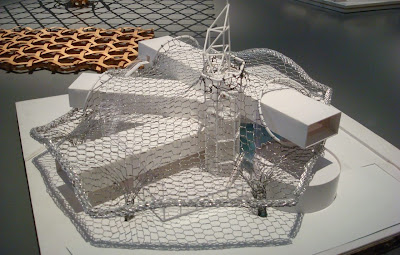 After years of planning and construction, after months of build-up, and after even a restructuring of bus routes, the Centre Pompidou - Metz opened its doors to the public this morning for the very first time. The original Centre Pompidou in Paris promoted its sister museum with a giant banner.
After years of planning and construction, after months of build-up, and after even a restructuring of bus routes, the Centre Pompidou - Metz opened its doors to the public this morning for the very first time. The original Centre Pompidou in Paris promoted its sister museum with a giant banner. Metz's new museum, likened to the Guggenheim's branch in Bilbao as a modern cultural treasure that could revitalize an economically disadvantaged region, captured the attention of the world's press. The press reports of the opening did not laud Metz for its own merits. Rather, Metz is "a military town off the tourist circuit." Reviews tended to lead with the wonder and strangeness of the museum's building, which was inspired by a Chinese hat.
Metz's new museum, likened to the Guggenheim's branch in Bilbao as a modern cultural treasure that could revitalize an economically disadvantaged region, captured the attention of the world's press. The press reports of the opening did not laud Metz for its own merits. Rather, Metz is "a military town off the tourist circuit." Reviews tended to lead with the wonder and strangeness of the museum's building, which was inspired by a Chinese hat.
 Off the tourist circuit or not, the museum drew huge crowds for its opening day, many from out of town. In line with us as we waited to enter were a group of women from Paris who had never before visited Metz but were here for the opening. Many Germans were in the crowds, too. We arrived at about 12:15 p.m., and had about a 30-minute wait to get into the building. Then, shades of Disneyland's hidden lines, we waited in another series of lines to get into the galleries. As the afternoon wore on, the lines got longer and longer, stretching away from the museum to the edges of its esplanade.
Off the tourist circuit or not, the museum drew huge crowds for its opening day, many from out of town. In line with us as we waited to enter were a group of women from Paris who had never before visited Metz but were here for the opening. Many Germans were in the crowds, too. We arrived at about 12:15 p.m., and had about a 30-minute wait to get into the building. Then, shades of Disneyland's hidden lines, we waited in another series of lines to get into the galleries. As the afternoon wore on, the lines got longer and longer, stretching away from the museum to the edges of its esplanade.The museum's inaugural exhibition, "Masterworks?," occupied all four floors of galleries. The ground floor's theme was the history of masterworks in art, and this story fittingly began with
 a 9th-Century ivory coffret from the School of Metz as its very first item. Other local masterworks, including a remarkably ornate crystal chandelier from the St-Louis glassworks, helped to tie the exposition to the region and strengthen the relationship of the museum to its location.
a 9th-Century ivory coffret from the School of Metz as its very first item. Other local masterworks, including a remarkably ornate crystal chandelier from the St-Louis glassworks, helped to tie the exposition to the region and strengthen the relationship of the museum to its location.The exhibition eventually moved to more modern works, including pieces by Pablo Picasso, Salvador Dali, Robert Delaunay, Sonia Delaunay, Ellsworth Kelly, Jackson Pollock, Fernand Leger--too many to recount, actually. The Pompidou Center has lent some 700 of its works, and other museums have lent another 100 or so. This show knocks your socks off. It culminated on the fourth floor with ultra-contemporary works. Along the way, there were simply marvelous works of all kinds, including this study by Theo van Doesburg for the projection wall of his Cine-Dansing de l'Aubette, of which I'd seen a model at the Strasbourg Museum of Modern and Contemporary Art.
 One of the key parts of the exhibition was the treatment of museums in France since 1937 as possible masterworks in themselves, which fit well with how the Centre Pompidou - Metz is being reviewed. An architect's model of the museum shows its real structure, not clearly understandable as you look at the finished building.
One of the key parts of the exhibition was the treatment of museums in France since 1937 as possible masterworks in themselves, which fit well with how the Centre Pompidou - Metz is being reviewed. An architect's model of the museum shows its real structure, not clearly understandable as you look at the finished building. The top-floor gallery points, on its northwest end, toward Metz's center city and its cathedral. The arrangement of the walls makes the cathedral loom large as you enter the gallery and recede as you move toward it.
The top-floor gallery points, on its northwest end, toward Metz's center city and its cathedral. The arrangement of the walls makes the cathedral loom large as you enter the gallery and recede as you move toward it. The view toward Metz, at the end of the exhibition, drew visitors like a porch light draws moths. It struck me, looking at the museum visitors looking at the city, that while the museum draws people away from the center of Metz, it ends up returning their focus to the city itself.
The view toward Metz, at the end of the exhibition, drew visitors like a porch light draws moths. It struck me, looking at the museum visitors looking at the city, that while the museum draws people away from the center of Metz, it ends up returning their focus to the city itself.

No comments:
Post a Comment